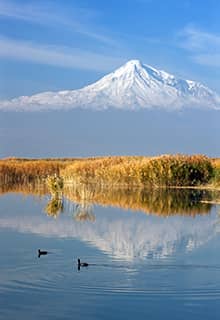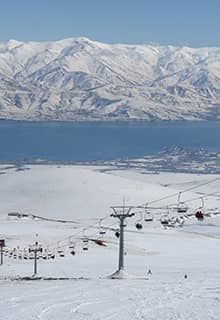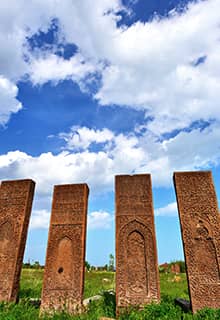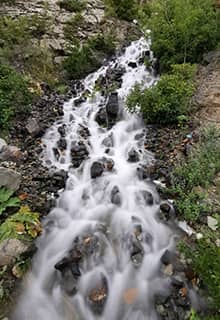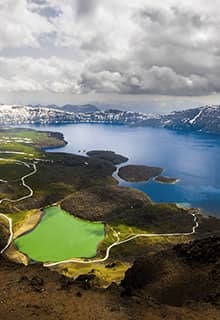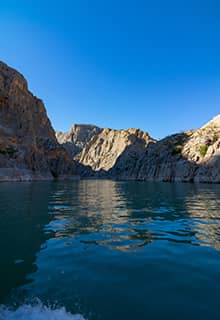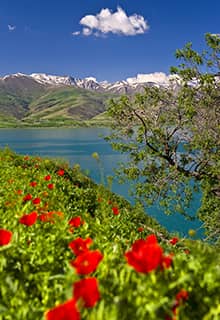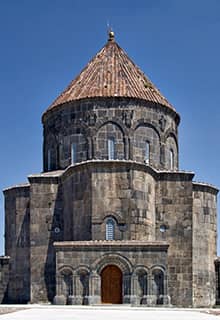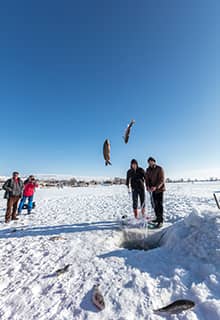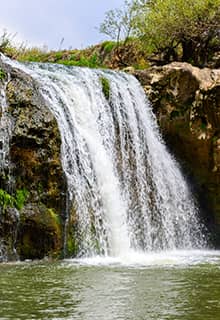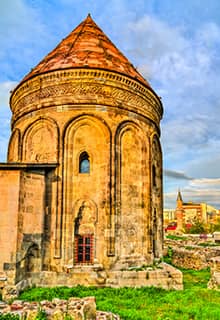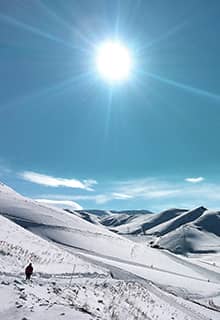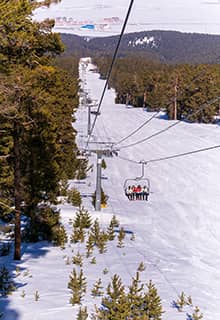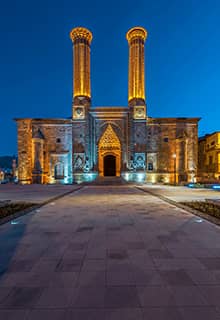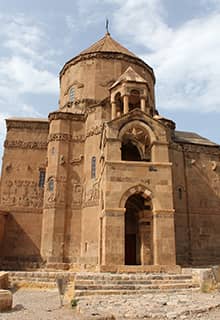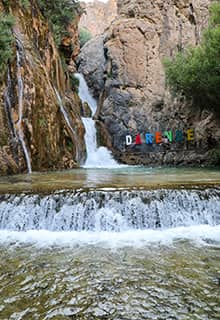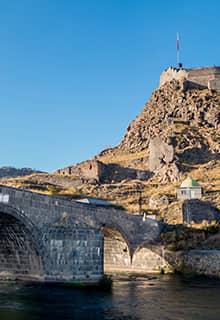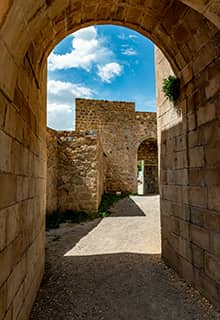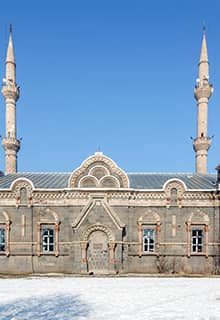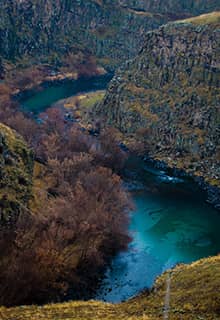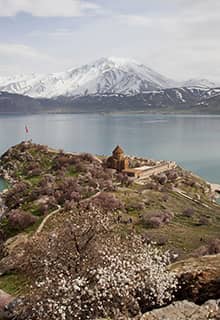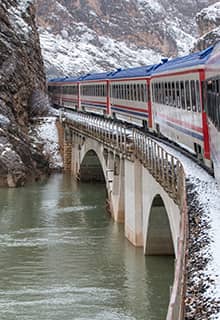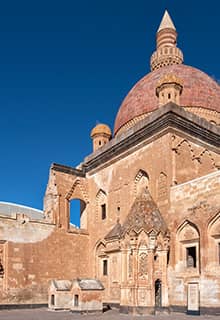

see
Eastern Türkiye
Ani Ancient City and Ruins in Kars
Ancient City of Ani (Ani Harabeleri), an ancient trading city on the Silk Road attracts attention with its buildings that carry the religious, administrative, military, and civil architectural examples of the period to the present day.
42 km from the city center of Kars, Ani Site located west of the Arpaçay River establishing the Turkish-Armenian border within the village limits of Ocaklı Village, is the largest ancient ruin in eastern Anatolia.
Although there are many important historical ruins in the city, visitors to Kars should definitely see the Ani Ruins, which is included in the UNESCO World Heritage List.
The walls surrounding the ancient city and the intact cathedral, mosque, caravanserai, bridge, etc. structures are the most important ruins in Ani. The ruins of a Zoroastrian temple can also be seen in the city.
Akdamar Church in Van
The Church of the Holy Cross or Akdamar Church (Akdamar Kilisesi or Surp Haç Kilisesi ) is located on Akdamar Island, the second largest of the four islands in Lake Van. It is a medieval Armenian Apostolic cathedral, built as a palatine church for the rulers of the Kingdom of Vaspurakan. Later, it served as the seat of the Catholicosate of Aghtamar, which was an independent see of the Armenian Apostolic Church and existed for almost eight centuries.
İshak Paşa Palace in Ağrı
The İshak Paşa Palace (İshak Paşa Sarayı) is an outstanding example of a 17th century Ottoman palace. The palace and administrative complex are located in the district of Doğubayazıt in the Ağrı province. Construction was completed by İshak Paşa, who was to give his name to the palace and who became the pasha of Çıldır from 1790 to 1791. According to the inscription on its door, the harem section of the palace was completed by İshak (Isaac) Paşa in 1784. The palace is one of the few examples of surviving historical Turkish palaces.
Tuşpa/Van Fortress, the Mound, and the Old City in Van
Tuşpa was the 9th century BCE capital of the Urartians, which later became the modern city of Van. The name “Van” derived from “Biainili”, the native name of Urartu. The ancient ruins are located just west of Van and east of Lake Van. Urartians were a people who lived in the same period as the Phrygians and created perhaps the most important civilization of Eastern Türkiye in this period. There has been speculation that the Urartian language perhaps was an early form of Armenian; however, linguistically, there is no connection between the two. The fortress is located on the southern shore of Lake Van. To its north, in the same direction, lies the Mound of Van Fortress and to its south the Old City of Van. Excavations at the mound have revealed 5,000 years of old settlement culture, while excavations in the Old City have revealed 800 years of urban life. The site has been occupied from the third millennium BCE to the beginning of the 12th century preserving an incredible wealth of humankind’s history.
The Tombstones of Ahlat the Urartian and Ottoman Citadel in Bitlis
Ahlat is located 50 km from Bitlis, at the edge of the biggest lake in Türkiye, Lake Van, with spectacular scenery. The history of the city dates back to 900 BCE, to the Urartian period; however, the famous tombstones here are from the 12th to 15th centuries. The tombstones belong to the Seljuk period and the most important ones are in Harabe Şehir Cemetery; Taht'ı Süleyman Cemetery; Kırklar Cemetery; Kale Cemetery; Merkez Cemetery, and Meydanlık Cemetery.
Archaeological Site of Arslantepe in Malatya
The Arslantepe Archaeological Site (Arslantepe Arkeolojik Sit Alanı) is at the heart of the fertile Malatya Plain, approximately 12 kilometers from the Euphrates. It is a 4-hectares and 30-meter-high tumulus (mound) dominating the plain. In the earliest phases of its history, in the Chalcolithic period around the 5th millennium, the settlement had close links to the Mesopotamian world, with which it shared many cultural features. But in the beginning of the Bronze Age, in the early third millennium BCE, important changes took place at the site that halted the development of the Mesopotamian-type centralized system and reoriented Arslantepe's external relations toward Eastern Anatolia and Transcaucasia (South Caucasus). A further radical change occurred in the second millennium CE, during the Hittite civilization, which exerted a strong influence on it. The unearthed king's palace is an open-air museum and the artifacts that have been excavated at the site are exhibited at the Malatya Archaeological Museum.
Twin Minaret Madrasa in Erzurum
Twin Minaret Madrasa (Çifte Minareli Medrese) is a Seljuk architectural monument that became the symbol of Erzurum. It is usually considered to have been built in late 13th century. It is also called "Hatuniye Madrasa” because it is assumed to have been built by Hundi Hatun, the daughter of Alaaddin Keykubat, or Padişah Hatun of the İlhanlı dynasty.
The decorations, especially at the crown door (Taç Kapı) of the madrasah, are magnificent examples of the aesthetic perspective in Seljuk stone decoration. Herbal elements were mainly used in the decorations.
On the western side of the crown door, the tree of life consisting of a double-headed eagle, two snakes with open mouths and sliced leaves, which are the symbol of the Central Asian Turks, are carved.
Mama Hatun Caravanserai in Erzincan
One of the largest architectural monuments of the city of Erzincan is the Mama Hatun Caravanserai (Mama Hatun Kervansarayı). The Mama Hatun Caravanserai has witnessed the history of Erzincan since its construction in the 12th century. It was commissioned by the Saltukid female ruler Melike Mama Hatun. The building is of yellow cut stone and it is rather ornate.
Arak Monastery in Muş
With many Roman architectural features, Arak Monastery (Arak Manastırı) has a history of about 1,500 years. The monastery was, however, most likely built in the 11th century. During the 12th-13th centuries it was a major center of learning. In the following centuries it was expanded, destroyed, and renovated. The name of the monastery, Arak is an old word for wine or alcoholic spirits. It is one of the steepest structures of Muş.
Mazgirt Castle in Tunceli
Mazgirt Castle (Mazgirt Kalesi), which is a monument belonging to the Urartu civilization, is a historical place which should be added to the list of places to visit in Tunceli. This strong structure has survived the ravishes of time. Old windmills can be seen at the top of the castle. In addition, the city views are among the best of anywhere hereabouts.
Harput Castle (Milk Castle), Elazığ
Built by the Urartians in the 8th century BCE, the castle is the oldest ruin of Harput survived up to the present day! The reason why Harput Castle (Harput Kalesi) is also called Milk Castle is the rumor that the milk obtained from the animals fed in the vicinity was used instead of water during the preparation of the mortar due to the drought during the construction of the castle. Located on a steep slope, Harput Castle has a fascinating view.
Yüzen Islands, Bingöl
Yüzen Islands (Yüzen Adalar) consists of three islands that move independently on a completely natural crater lake surrounded by mountains on three sides. It is 4.5 km away from Bingöl - Solhan highway. The depth of the lake is more than 50 meters and is fed by a continuous stream of fresh water. The most distinctive feature of the lake is that the three islands in it move independently, like a raft, within the lake. The stunted ash trees on these islands also enhance the visual beauty of the Yüzen Islands. The water of the lake is sweet and clear.
Harmandöven Ejder Caravanserai, Iğdır
The caravanserai was built in the 13th century by the Amir of the Surmari, Şerafettin Ejder Bey, during the Seljuk period on the caravan route between Batumi-Tabriz, which is one of the side roads of the Silk Road.
Cilo Sat Mountains National Park, Hakkari
Cilo Sat Mountains National Park (Cilo Sat Dağları Milli Parkı) is located at İki Yaka Mountains in Yüksekova district. At the summit of Cilo Sat Mountains National Park there are cirque and glacial lakes where is convenient not only for hiking also for scientific climbing. There are glaciers, glacial lakes and cert diversified wild animals on these mountains.
Each being a natural wonder, these areas are suitable for winter sports and recreational activities. Cilo Sat Mountains National Park provides mountaineers many opportunities with no need for using any auxiliary equipment and tools and is an important ecological center and outdoor sports area. Mountain has many routes in different difficulty levels preferred by climbers according to their experience, as well as is rich in natural landscapes.

